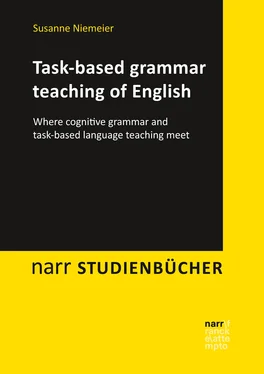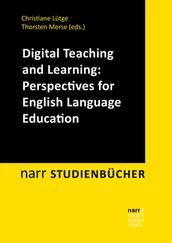Cognitive linguistics holds that since our knowledge of specific instances of language includes knowledge of the contexts in which linguistic units are encountered, knowledge of discourse and pragmatic constraints is established along with knowledge of the words and phrases or sentence patterns of the language. Saying that language is usage-based, that it is learned through usage events or contextualized encounters with members of the discourse community using the language, means that we learn the language as contextualized, discourse-oriented information. (TYLER 2012: 53)
In cognitive linguistics, grammatical constructions are never seen as standing on their own, and they not only depend on correct and adequate word usage and grammar but additionally on an adequate situational context of the usage event, on potential pragmatic constraints (an example would be politeness in discourse, i.e., to know how to speak to whom, to not use colloquial phrases in academic papers and the like) as well as on the form of discourse chosen (jokes are not told at funerals and seminar presentations are a different discourse type than chatting on the internet, for example). Therefore, L2 learners not only have to acquire the vocabulary and grammar of the foreign language but additionally have to pay attention to all the above-mentioned factors in order to gain communicative competence.
This ties in with what VALENZUELA MANZANARES/ROJO (2008: 198) claim, namely that “the process of learning a language can also be seen as the process of acquiring the relevant cognitive patterns which codify the conventions of use of that language” and these patterns can be learned from specific usage events. In contrast to L1 acquirers, however, L2 learners are normally not exposed to their second language at the same level of frequency, which is why carefully designed instructional interventions, in the sense of what VALENZUELA MANZANARES/ROJO are referring to, are necessary in order to facilitate the learners’ acquisition of a given grammatical construction. This is one of the reasons why L2 instructors should make sure that the targeted grammatical constructions are embedded in those chunks and phrases in which they are conventionally used by native speakers of the language in question. This focus on communicative usage is also one of the reasons why cognitive linguistics is able to collaborate well with a communicative approach to language learning, whereas traditional linguistic approaches did not give usage an important role.
Before the perspective is narrowed down to the discussion of cognitive grammar, a final comment on the role of cognitive linguistics in Germany is appropriate, as the focus of attention in this book is mainly a local one, namely on German learners acquiring English as a second language. As mentioned earlier on, in its beginnings cognitive linguistics was an American approach. It started out in the USA as a relatively small countermovement but has since experienced an enormous growth in its theory as well as in the numbers of researchers and followers that it has attracted and is still attracting, basically all over the world. In the late 1980s, cognitive linguistics entered Europe, mainly due to the efforts of DIRVEN, whom GEERAERTS (2006: 21) describes as “undoubtedly the major organizational force of the entire Cognitive Linguistics enterprise” and who in 1989 organised the first European conference on this topic (which was later on, in retrospect, called the first international cognitive linguistics conference) at the University of Duisburg. On this occasion, the International Cognitive Linguistics Association (ICLA) was founded and the journal Cognitive Linguistics (published by De Gruyter Mouton) was launched. This conference hosted about 60 participants1, and has been held every two years since then, today frequently attracting more than 1000 participants.
Since cognitive linguistics has grown so much since its early days, quite a lot of sub-fields have developed, although the research activities in all areas of this very active academic field still predominantly rely on LAKOFF’s, TALMY’s and LANGACKER’s early research, which has of course been refined and partly reformulated. National associations of cognitive linguistics have been founded in quite a number of countries, also in Germany (DGKL/GCLA – German Cognitive Linguistics Association2 with more than 300 members, which also organises biannual international conferences).
As the field of cognitive linguistics has grown and become more extensive and as basic theories and models have been developed, it was a logical next step to look at applications for the theoretical underpinnings. One of the obvious areas of application for theories which explain language is certainly second/foreign language acquisition. Bringing theory into language instruction means to provide instructors with a solid foundation that teachers and learners can build upon. In more than 40 years, the generative paradigm did not manage to develop a teaching approach that has found its way into textbooks and/or classrooms and even CHOMSKY himself has said that the generative approach is probably not applicable to the foreign language classroom3. This, however, is different for cognitive linguistics, and in particular for cognitive grammar. Although the approach is still too young to have found its way into foreign language textbooks, the number of research articles and experiments testing the effectiveness of teaching along cognitive-linguistic lines is steadily growing. A lot of this research has been done in the field of cognitive grammar, which is discussed in the next sub-chapter.
3.2 The cognitive grammar perspective on language
Much that was said in the previous sub-chapter has already alluded to cognitive grammar beliefs and principles, as cognitive grammar is a prominent field of research within cognitive linguistics and therefore shares its basic assumptions, which were outlined in the previous sub-chapter. Cognitive grammar is not a completely uniform approach1, however, what all current frameworks have in common is that they treat language as an integral facet of cognition and regard grammatical phenomena as meaningful. They are not as concretely meaningful as lexical structures are, but they are meaningful in a more abstract way. LANGACKER (2008: 67) calls this “a matter of degree, so there is no clear line between lexicon and grammar”. Cognitive grammar aims at investigating “the ways in which people structure their experiences through language” (NIEMEIER 2013: 11), “based on the assumption that situations are generally not reflected directly in linguistic forms but by means of elaborate cognitive construals” (ibid.).
3.2.1 The centrality of meaning
The research field of cognitive grammar was introduced and developed by LANGACKER, who sees grammar as consisting of symbolic relationships, i.e., form-meaning pairings: “lexicon, morphology and syntax form a continuum of symbolic units serving to structure conceptual content for expressive purposes” (LANGACKER 1987: 35). A symbolic unit consists of the pairing of a semantic structure and a phonological structure. The primary function of language being communication, language – including its grammar – is all about meaning. As mentioned before, linguistic meaning is not seen “as referential and objective, but as subjective, dynamic, flexible, encyclopaedic and usage-based” (NIEMEIER 2013: 14). LANGACKER stresses the centrality of meaning in cognitive grammar as well when he comments in a somewhat funny way:
If generative linguistics views syntax as being central to language, Cognitive Linguistics accords this honor to meaning. The latter seems far more natural from the perspective of language users. When ordinary people speak and listen, it is not for the sheer pleasure of manipulating syntactic form – their concern is with the meanings expressed. This does not of course imply that grammar is unimportant in language or in language teaching. It is, however, helpful to realize that grammar subserves meaning rather than being an end in itself. (LANGACKER 2008: 67)
Читать дальше












